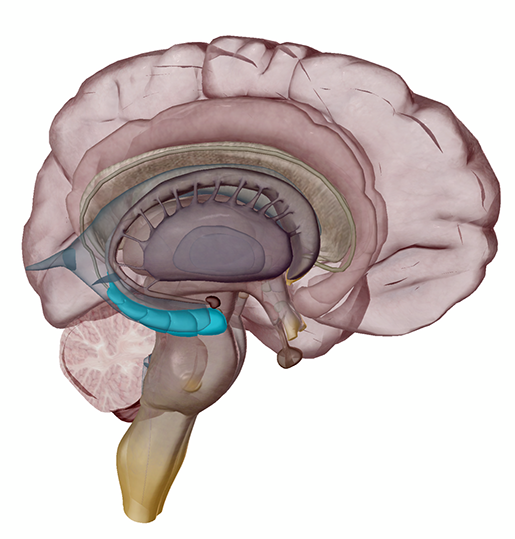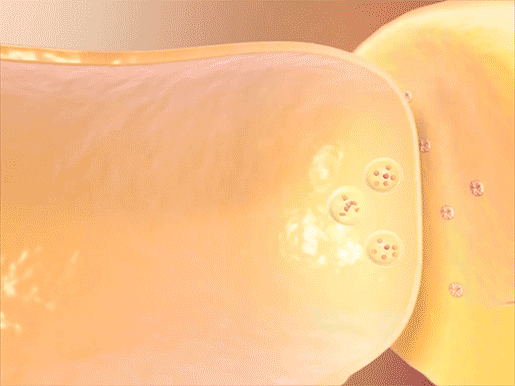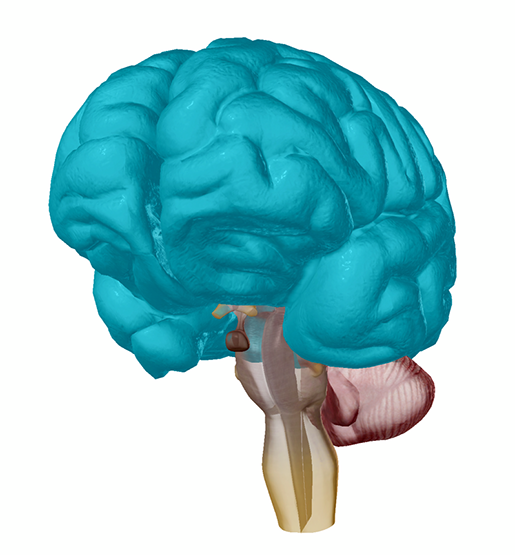5 Facts About Alzheimer's Disease
Posted on 6/3/20 by Laura Snider
Alzheimer’s Disease is a neurodegenerative condition that impairs memory and cognitive functioning. It affects around 5.5 million Americans, most of them over the age of 65, and is the 6th leading cause of death in the US.
Today we’re going to discuss five facts about Alzheimer’s that will help you understand its symptoms, its stages of progression, its potential risk factors, and some forms of treatment that can help slow it down.
Need a refresher on the structures of the brain? Check out this virtual brain dissection video with 3D visuals from Human Anatomy Atlas!
1. Alzheimer's Disease is the most common cause of dementia in older adults.
Sometimes people confuse the terms Alzheimer’s and dementia. Alzheimer’s disease is responsible for 50-70% of all cases of dementia, but dementia isn’t a specific condition in itself. Instead, it’s a series of symptoms that can be caused by a number of different conditions, such as Alzheimer’s disease, stroke, vascular diseases, Parkinson's disease, and Huntington's disease.
Dementia caused by these conditions is generally permanent and progressive, meaning it can’t be reversed and it gets worse over time. Dementia that is caused by depression, medication side effects, and thyroid problems can be reversed with treatment.
What are the symptoms of dementia? Usually, dementia begins with forgetfulness. The memory problems that often serve as early signs of dementia result from damage to the neurons of the hippocampus, a part of the brain essential to learning and memory.
 The right hippocampus (highlighted). Image from Human Anatomy Atlas.
The right hippocampus (highlighted). Image from Human Anatomy Atlas.
As dementia progresses and neurons throughout the brain continue to be damaged and die, individuals may exhibit depression, aggression, difficulty with language, and other changes in thought and behavior. Eventually, they lose the ability to carry out everyday tasks and require round-the-clock care.
Diagnosis of dementia (and Alzheimer’s) can be a complex process, involving “medical history, a physical examination, laboratory tests, and the characteristic changes in thinking, day-to-day function and behavior associated with each type.” Doctors or other health professionals may conduct memory and cognition assessments such as the MMSE (Mini Mental-State Exam) and the Mini-Cog test. They might also utilize brain imaging methods such as MRI (magnetic resonance imaging) and CT (computed tomography) scans. Structural brain imaging can be especially helpful in seeing if a tumor, stroke, or brain damage from an injury is the cause of a person’s dementia.
2. Alzheimer's Disease gets its name from the doctor who first identified it: Alois Alzheimer.
Alzheimer’s Disease was identified in 1906, after German psychiatrist and neuroanatomist Dr. Alois Alzheimer examined the brain of a deceased patient who had experienced “memory loss, language problems, and unexpected behavior.” When the patient, Auguste D., was first admitted to Alzheimer’s care in 1901, he took careful notes on her symptoms, which included “sleep disorders, disturbances of memory, aggressiveness, crying, and progressive confusion.”
In looking at the patient’s brain tissue after her death five years later, Alzheimer found unusual protein plaques (amyloid-beta plaques) and tangles of fiber (tau clusters). Today, we know that these abnormal collections of proteins interfere with the primary cells of neural tissue—neurons.
Amyloid-beta plaques form between neurons and disrupt their ability to communicate with each other. Tau tangles form inside the neurons themselves, blocking their transport system and therefore also harming the synaptic communication between neurons.
 An electrical signal passing from one neuron to another at a synapse, with the help of neurotransmitters (in red). Video footage from Anatomy & Physiology.
An electrical signal passing from one neuron to another at a synapse, with the help of neurotransmitters (in red). Video footage from Anatomy & Physiology.
Another neurobiological process that is disrupted in Alzheimer’s disease is the function of microglia. Normally, these cells support proper brain function by clearing away waste, plaques, and debris that collect around neurons.
Here’s another interesting (but not so fun) fact. Tau tangles have been found post-mortem in the brains of people suffering from other neurodegenerative disorders, like CTE (chronic traumatic encephalopathy), which results from repeated head trauma. Given that tau tangles disrupt normal inter-neuron communication, it follows that people with CTE experience dementia-like cognitive dysfunction much earlier in life than is typical.
3. The progression of Alzheimer's is divided into three general stages.
There are three main stages of Alzheimer’s: early, middle, and late. Each stage has a distinct set of commonly-seen symptoms, degree of damage to the brain, and treatment options associated with it. The Alzheimer’s Association estimates that people typically live for 4-8 years after diagnosis, but there is a large degree of variation depending on the individual.
Early:
Alzheimer’s typically begins with small memory lapses while a person is still relatively independent. That is, a person with early-stage Alzheimer’s can still carry out everyday activities and care for themselves. Sometimes, however, they might have trouble remembering words, names, or new information. They might also misplace objects and start having difficulty with planning and organizational tasks.
Once these behavioral changes have become apparent to the individual experiencing them, or to their friends and family, it’s a good idea for that individual to be evaluated by a medical professional and discuss how to mitigate the disease’s effects as it progresses.
Middle:
The middle stage of Alzheimer’s is when the most behavioral changes take place. It’s usually the stage that patients are in for the longest period of time.
During the middle stage, forgetfulness intensifies from new information to personal history, such as memories of events, or important information, such as addresses and telephone numbers. A person with middle-stage Alzheimer’s might also experience altered sleep patterns, impaired bladder and bowel function, confusion, and changes in mood. They might withdraw socially, and they will likely begin to have difficulty with personal hygiene and require help with everyday tasks.
As the disease progresses, damage to and death of the neurons of the cerebral cortex continues.
 The cerebral cortex, or cerebrum: home to language, thought, and decision making. Image from Human Anatomy Atlas.
The cerebral cortex, or cerebrum: home to language, thought, and decision making. Image from Human Anatomy Atlas.
Late:
Individuals with late-stage Alzheimer’s disease require extensive care. During this stage, their dementia has progressed to the point where they have serious difficulties communicating and interacting with their environment. Their ability to walk, sit, and even swallow eventually declines. People with late-stage Alzheimer’s often become more susceptible to infections such as pneumonia, which can prove deadly.
4. Though the symptoms and characteristics of Alzheimer's are well understood, the causes and risk factors are still being researched.
Although doctors have a good understanding of the symptoms (dementia and behavioral changes) and physical evidence of Alzheimer’s disease (beta-amyloid plaques and tau tangles), it’s less clear what causes the condition. That’s one reason a definitive cure has been elusive.
Studies have shown that there is a genetic component to Alzheimer’s disease. Having a particular variant of the APOE gene (APOE ε4), for instance, can increase a person’s risk of developing Alzheimer’s. APOE is involved in producing a protein that helps carry cholesterol and other fats in the bloodstream. It’s estimated that about 25% of people carry one copy of APOE ε4. People get one copy of APOE from each of their parents, so depending on their parents’ genes, a person can have up to two copies of APOE ε4. They might not have any—instead, they may have some combination of APOE ε2 and APOE ε3.
It’s important to note that having the APOE ε4 variant doesn’t guarantee that someone will develop Alzheimer’s, and not having the APOE ε4 variant doesn’t guarantee that they won’t. APOE is only one component of a complex set of risk factors.
A person’s risk of developing early-onset Alzheimer’s (before age 65) has been connected to mutations to several different genes: amyloid precursor protein (APP) on chromosome 21, presenilin 1 (PSEN1) on chromosome 14, and presenilin 2 (PSEN2) on chromosome 1.
Lifestyle and environmental factors likely also play a role in the development of Alzheimer’s disease. People with type 2 diabetes, people who have suffered head injuries, and people with high blood pressure and/or cholesterol are more likely to develop dementia as they age. Smokers are 45% more likely to develop Alzheimer’s.
Though there isn’t necessarily a way to “stop” Alzheimer’s from developing, there are a lot of things people can do to stay healthy as they age and thus decrease their environmental and lifestyle risks. These healthy habits include eating a nutritious diet, exercising regularly, staying socially engaged, participating in mentally stimulating activities, and maintaining a consistent sleep schedule.
5. There is no cure for Alzheimer's, but treatment can slow the disease's progression.
Researchers are still searching for a cure for Alzheimer’s. However, there are several pharmaceutical treatments available that may alleviate some symptoms, allowing patients in the mild and moderate stages of the disease to retain better quality of life.
Medications called cholinesterase inhibitors help prevent the breakdown of the neurotransmitter acetylcholine in the brain, which helps networks of neurons that use acetylcholine at their synapses to communicate. Given acetylcholine’s role in memory and thinking, having more acetylcholine in the brain could improve the memory function of someone with Alzheimer’s.
Another series of drugs used to treat Alzheimer’s deals with the neurotransmitter glutamate. Glutamate is important for normal brain function, but excessive amounts of glutamate can damage or even kill neurons. Therefore, medications like Namenda (memantine), an N-methyl D-aspartate (NMDA) antagonist, can help Alzheimer’s patients by regulating glutamate levels.
Because they act on different neurotransmitters using different chemical interactions, a cholinesterase inhibitor and NMDA antagonist can be used together.
The types of medications mentioned above help preserve cognitive functions, but there are also drug and non-drug ways of managing the behavioral symptoms of Alzheimer’s. Antidepressants might be used to help with some of the mood changes experienced by people with Alzheimer’s.
In addition, there is a wide variety of strategies that family members and caregivers can use to help keep a person with Alzheimer’s safe and to manage their behavioral changes in an empathetic manner. For example, making modifications to the living space of someone with Alzheimer’s is advised. Medications should be kept in a secure location and objects such as keys, wallets, and phones should be kept in consistent locations. It’s also important to make sure that a person with Alzheimer’s wears a medical alert bracelet and carries ID. Fall risk should be minimized with railings, the removal of clutter and throw rugs, and making sure the person with Alzheimer’s wears shoes or slippers with good traction.
As for managing behavioral symptoms, the NIH advises keeping communication simple, maintaining daily routines, and providing reassurance.
There’s no denying that Alzheimer’s is a devastating disease, but there are many organizations that are dedicated to finding a cure. The Alzheimer’s Association is the big Alzheimer’s research sponsoring nonprofit here in the US—their chapters organize fundraising events and host online or in-person support groups for patients and caregivers. Volunteering, donating, and participating in awareness events are all great ways of contributing to the fight against Alzheimer’s.
Be sure to subscribe to the Visible Body Blog for more anatomy awesomeness!
Are you an instructor? We have award-winning 3D products and resources for your anatomy and physiology course! Learn more here.



